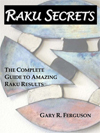|
- Article - Site Navigation Home Raku Artist Bio Raku Gallery Free Raku Glazes Raku Define Raku Links Raku Articles Raku Books |
Piepenburg Workshop III - Glazes and FiringIn the last two months' newsletters I covered the wheel techniques and handbuilding techniques that Robert Piepenburg used during a recent workshop I attended. This month I cover the glazing and firing tips and techniques he shared. While this workshop did not actually involve a Raku firing, Piepenburg did discuss several tips and methods involving glazes and firing. There are interesting Raku glazes that involve the use of silver nitrate. This is the same chemical that is used in photo developing and is very light sensitive. I had always resisted the use of this material because it was expensive and I didn't know how to store it to keep it from being damaged if exposed to light. His wife Gail uses this type of glaze a lot and all she does to protect it from being damaged from light is simply keep it in a dark solid jar. That seems pretty simple. When asked how he applied glazes to produce his copper matte effects, he stated he typically sprays or pours the glazes that are in a water-like consistency. He does little to no brushing. There were a few tips that Piepenburg provided that dealt with firing. For example he makes many of his pieces with a very small base because a smaller base is much less likely to crack during the firing. He also places the piece on a cool brick each time to reduce thermal shock. Another interesting thing he does is he only fires one piece at a time, regardless of the size of the piece. This way he can concentrate on how glaze on just one piece is maturing and does not have to worry about any negative effect of uneven firing that can occur when multiple pieces are fired. To get an accurate representation of the temperature in the kiln he uses a digital pyrometer. In fact some glazes he is very careful as to what temperature to pull the piece. For example a piece with the Alligator glaze is fired for around 45 minutes and is pulled at 1875F. He doesn't focus too much on whether the kiln is fired in oxidation or reduction. The only time he cares is with the firing of clear crackle glazes. He says he gets gray results (instead of white) if the piece is fired in reduction. He reduces using a sand pit. The piece is pulled and placed on a brick that has straw on and around it. Then a can is placed upside down over the piece and the rim is pressed into the sand. After 3 or 4 minutes, the can is burped (quickly opened and closed) for about 1 second In some cases he places the combustibles in the bottom of the can and then presses a wire mesh over the combustibles to hold the contents in place. Then when the can is over turned, the combustibles stay in the bottom (which is now the top), but the heat still ignites the combustibles to product a reduction atmosphere. Some pictures from the workshop can be seen at: |
||
|
Books
Learn Dozens of Hints, Tips and Techniques in the free monthly newsletter Just
Raku Privacy Policy - Your email address or other personal information will only be used for this newsletter. It will never be given, rented, or sold to any other party for any other purposed. |
||
|
Gary R. Ferguson - Raku Artist (c) Copyright 2005, Gary R. Ferguson |
||



